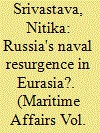| Srl | Item |
| 1 |
ID:
154585


|
|
|
|
|
| Summary/Abstract |
The Indian Ocean can be a convergent and cooperative maritime space for India–Russia relations. Russia can achieve its ambitions to re-emerge as a “great power” and as an influential global player in international politics, while India can reinforce its dominance in the region. Since the 18th century, Russia has sought a presence in the Indian Ocean, and there is a long history of Soviet naval forces operating in the region. However with the disintegration of the Union of Soviet Socialist Republics (USSR), its influence was reduced dramatically. The increasing importance of the Indian Ocean to Russia has been driven by the fact that it is the home to two competitive economies – China and India – along with other emerging Indian Ocean Region countries. On the other hand, increasing Chinese activity, especially its ambitious One Belt One Road (OBOR) initiative through the Indian Ocean Region, and Russia's interest in joining the China–Pakistan Economic Corridor (CPEC) may have threatened India's interests. While considering Russia–India relations, little has been explored beyond defence cooperation. Besides, India's cold response to the OBOR initiative may lead to its marginalisation in the region.
|
|
|
|
|
|
|
|
|
|
|
|
|
|
|
|
| 2 |
ID:
150589


|
|
|
|
|
| Summary/Abstract |
Russia is a leading actor seeking regional influence in Eurasia. Among many aspects of its re-emerging profile, the Russian navy's pre-eminence in the region is noteworthy. Immediately after the disintegration of the USSR, a lack of funding dealt a blow to the Russian navy. However, with the aim of restoring Russian naval power, President Putin began to modernise the Russian navy. Therefore, after setting the backdrop and the strategic outlook of Russia, the study first examines the drivers behind Russia's quest for resurgence and goes on to analyse the trends and intentions of the Russian navy, especially in the four seas of Eurasia – namely the Black Sea, Baltic Sea, Mediterranean Sea and Caspian Sea. The paper also attempts to compare the Russian navy's strength with that of the erstwhile Soviet navy. The study concludes that in order to attain the erstwhile Soviet Union's naval power, Russia would need to overcome a major economic crisis as well as geopolitical challenges.
|
|
|
|
|
|
|
|
|
|
|
|
|
|
|
|